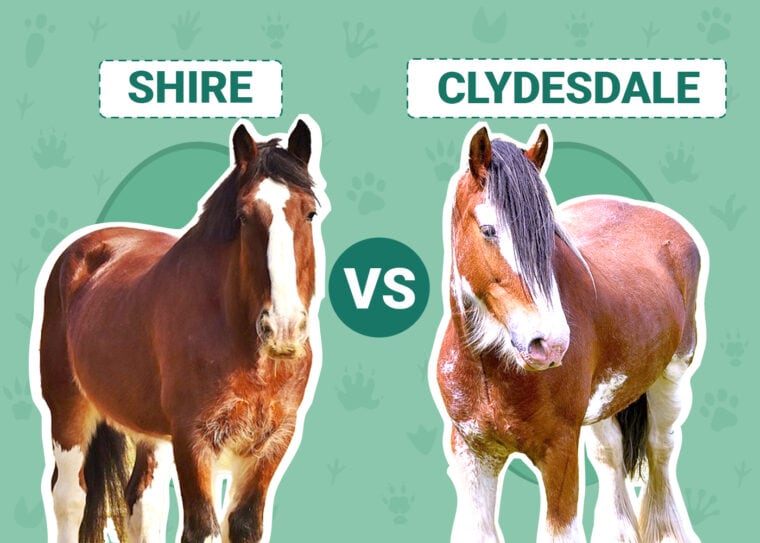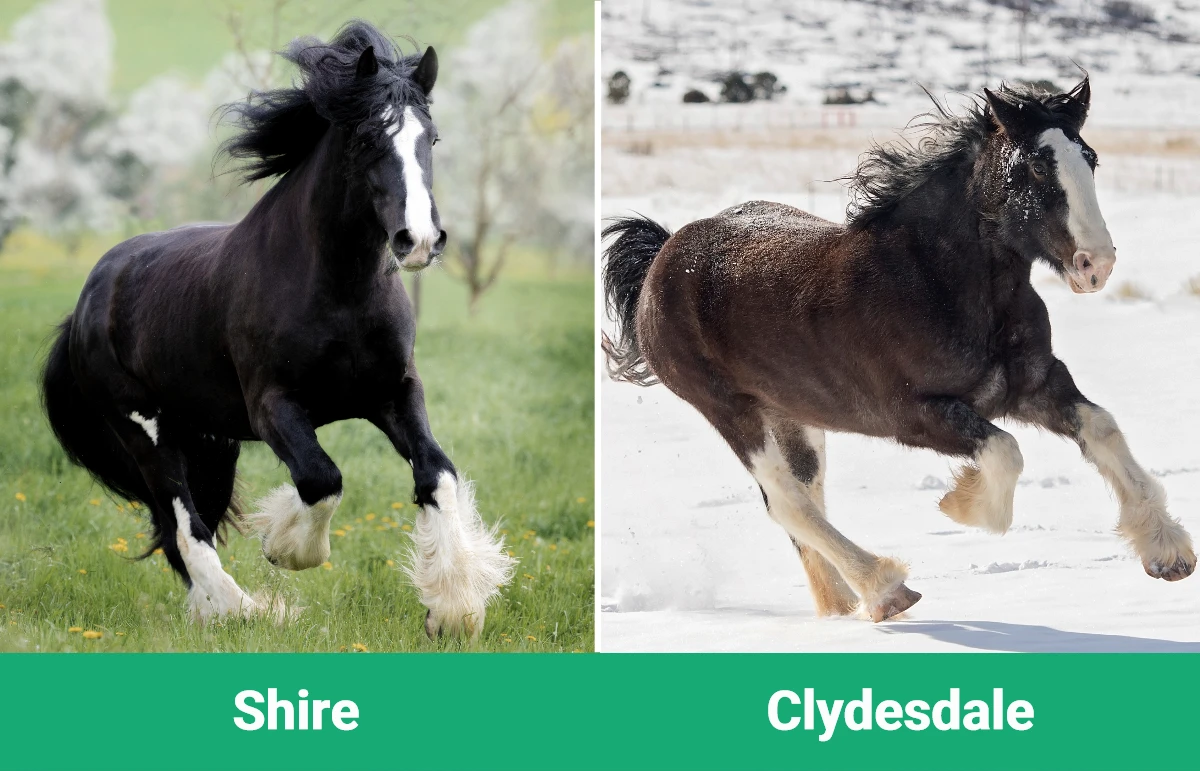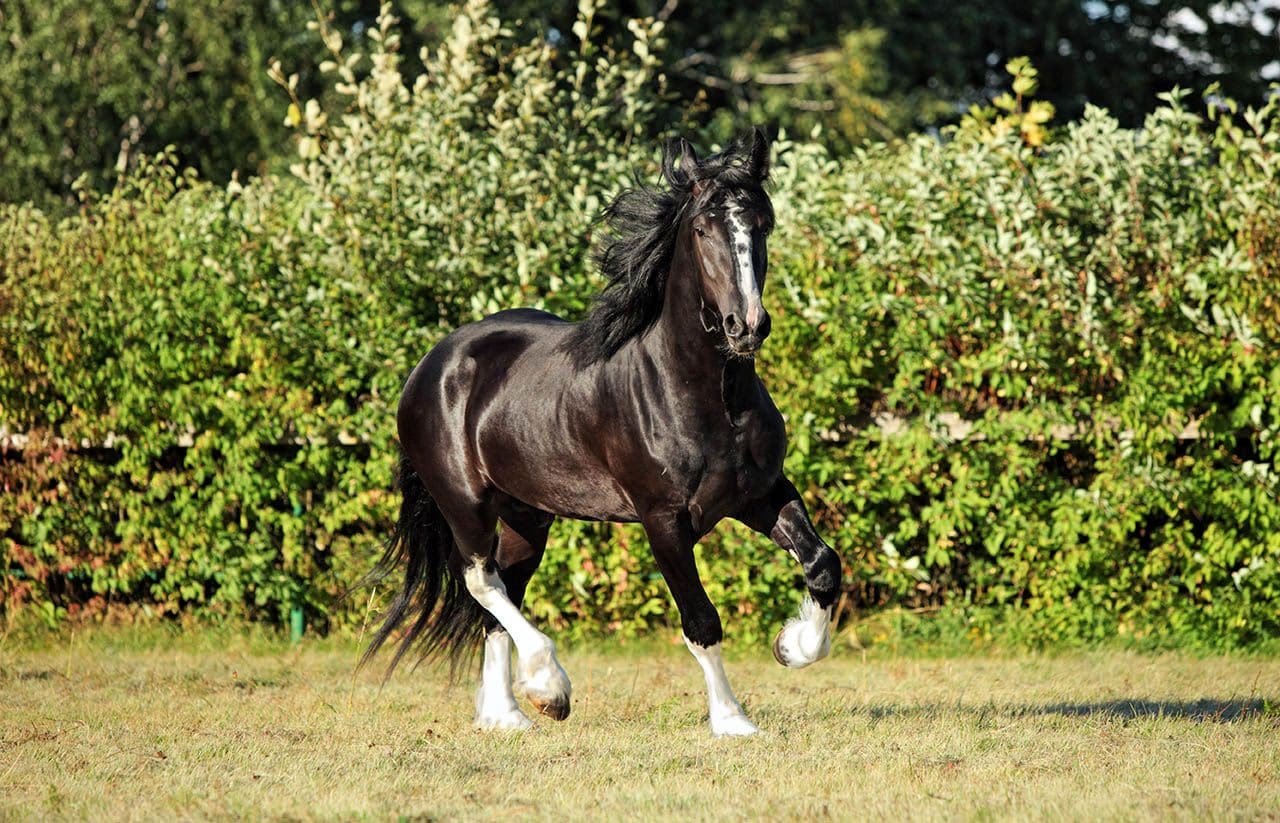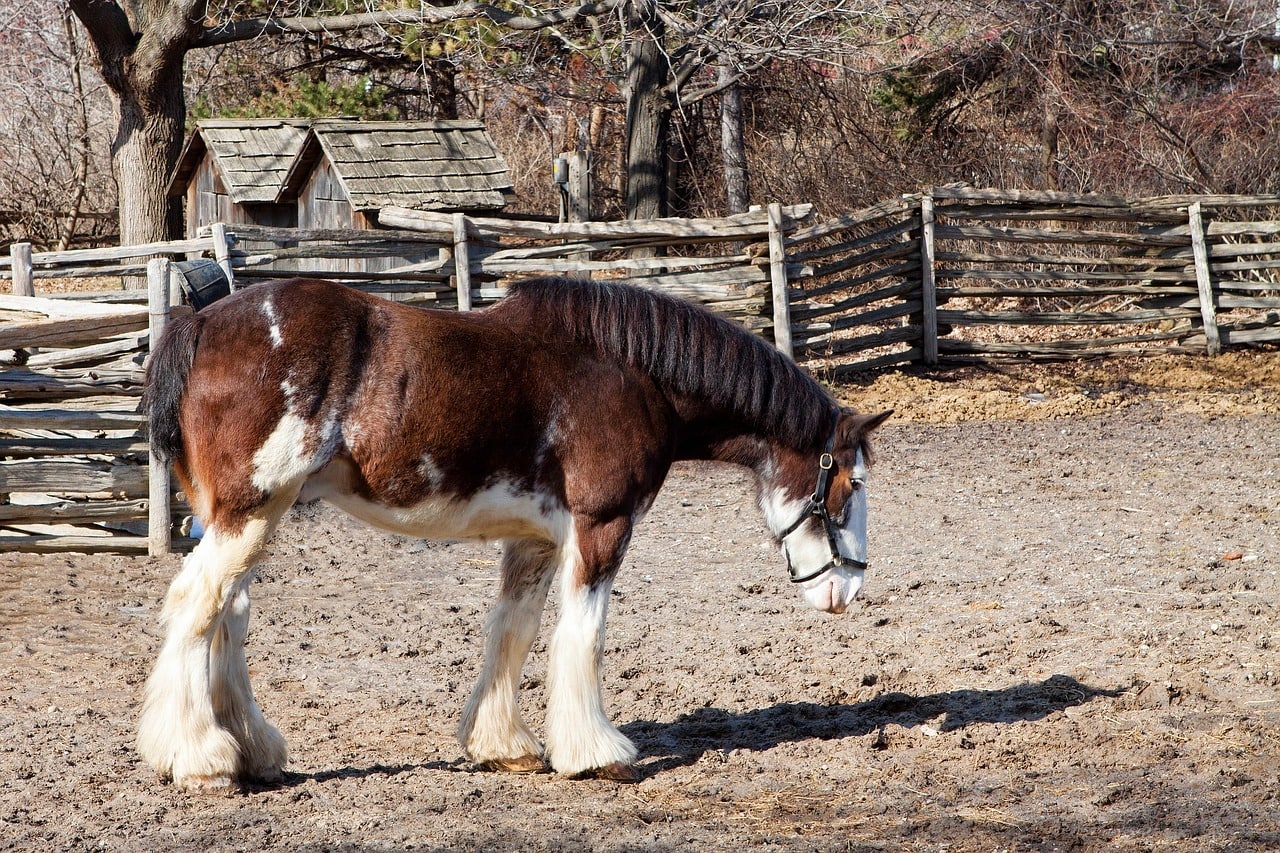
There is such an exquisite sense of power when you look at a draft horse. These muscle machines are usually gentle giants with calm dispositions and incredible work ethic. When it comes to a breed comparison, you might wonder what the difference is between them.
Two prevalent draft horse breeds that you might see are the Shire and Clydesdale. Toting brute strength, these horses have toiled diligently aside man to help us over generations with various tasks. Let’s learn a little bit about how these two astounding equines differ—and how they mirror each other all the same.
Visual Differences

At a Glance
Shire Overview
The Shire horse has ancient roots that date all the way back to 1066 after the Norman Conquest. In the Middle Ages, these horses were often written about by medieval writers. The breed is gigantic, holding records for being some of the most robust courses throughout history.
While the origin of the horse dates back far, a breed society was not formed until 1876. Many Shires were exported throughout various parts of the world, including the United States.

By the 1960s, the need for these horses decreased drastically because of modern advancements. Many of these horses were sold to slaughterhouses once their value diminished.
In an attempt to revamp the breed, many breeders had to board the revival train in the 1970s. Breeders consider the shire horse a rare sight to behold nowadays, painting them as at risk today.
Personality/Character
Shire horses are incredibly docile and easy to work with. They have a strong desire to learn new things, so teaching them tends to be much easier than some other breeds. These horses have an extreme sense of work ethic and fare best when they have a job to do.
Because of their given tasks, it is an excellent thing that they have such sweet personalities. Their size alone can overpower any human being easily, but they are agreeable and willing to train.
Their easy-going demeanor makes them an ideal pick for beginners and seasoned owners alike.
Physical Traits
Shire horses are recognizable because of their massive structure and feathered hair on their legs. Though many draught horses share several similarities, these horses are coarse and thick in form, creating a physically capable horse that is ideal for pulling weight and performing laborious work.
Shire horses typically stand 17 hands high, and they can weigh up to 2,000 pounds or more. Stallions and mares might be different colors. Stallions tend to be gray, brown, black, and bay. Mares, on the other hand, can be black, gray, brown, or roan.
Either gender can also be chestnut—although, in some regions, it is not a desirable color.

Purpose
Shire horses have served several purposes throughout history. They have been given tasks related to pulling carts, doing farm work, pulling wagons, and working in fields.
Today you might find a Shire horse pulling a carriage or saddled up for a ride. Generally, these horses aren’t used for heavy labor anymore, although they are still more than capable of doing so.
Health & Care
Even though these horses are generally healthy, they are prone to a neuromuscular disease called polysaccharide storage myopathy. Essentially what this disease does is cause hind leg muscle spasms. You can avert this problem by feeding your Shire horse a diet that is high in fat.
Even though their legs’ feathered appearance is a desirable trait, they can be tough to care for. Keep their feathered hair and hooves clean and debris-free so they don’t have any problems.
Because they are incredibly large draft horses, they can live up to 20 years or more, but their life spans are shorter than many other equines.
Suitable for:
These horses make a charming addition to farms looking for a physically healthy horse with the ability to handle incredible amounts of weight. Because of their demeanor, they are also ideal riding horses that can train young riders.
However, always make sure that the rider feels comfortable and safe due to the Shire’s size.
Clydesdale Overview

This Scottish breed comes from the county of Lanarkshire in Scotland. They were developed in the 18th century when breeders crossed Flemish stallions and local mares.
Later, Shires were introduced into the mix as well. The Clydesdale’s name did not come about until 1826 as these horses rapidly spread through certain parts of Europe.
The breed also surged in popularity in Australia and New Zealand when they were exported from Scotland in the 20th century. Though the breed is diligently protected, they still are considered rare.
Olden day Clydesdales were much heavier than they are today. This might be because they aren’t used to as much strenuous labor as their ancestors.
Clydesdales in America is most well known for their Budweiser connections. This beer company has taken on Clydesdales as their mascot since 1933.
Personality/Character
Clydesdales are calm but energetic horses that are easy-going but always up for work. They have a puppy spirit about them which makes them eager and ready to learn.
The term “cold-blooded” stems from these types of horses being calm, cool, and collected. Their level-headedness makes them compatible with people of all ages.
Physical Traits
While still massive in portions, the Clydesdale is slightly smaller than their draught cousins. These horses are considered slightly more compact in their build, although they are still solid and muscular.
These horses usually stand between 16 and 18 hands high. They can weigh between 1,800 to 2,300 pounds. Clydesdales have the classic feathering around their legs.
Classically, Clydesdales are bay colored with Sabine pattern—but they can also be black, gray, and chestnut. They generally have white markings on the face and legs. There might also be white markings on the belly portion.
Purpose
Many early Clydesdales were used for hauling purposes as well as agriculture production. You might have also witnessed them logging or pleasure riding.

Clydesdales have become quite the horses in the limelight, given roles that require participation and many human activities. Many times you will see Clydesdales taking charge of carriages and parades showing off their beautiful majesty.
Health & Care
Clydesdales can carry genetic health problems that are commonly seen in draft horses. They also suffer from what is called chronic progressive lymphedema, which is a disease that causes swelling of the limbs.
Because of the heavy feathering around their legs, they are also subject to a condition called Clyde’s itch, a skin condition that causes itching comparable to mange. To prevent this issue from happening, you must keep this area and its hooves clean and dry.
Suitable for:
Clydesdales work best when they have work to do. Whether you need their muscle power or just want companionship—these horses are up for the task. Their demeanor makes them suitable options for all experience levels if you are comfortable with their immense size.
Shire vs. Clydesdale: Let’s Compare!
Both the Shire and the Clydesdale are incredibly similar in both physical and mental ways. Shires are typically larger by a slight margin than the Clydesdale, but they do share the same structure. Clydesdales are slightly more compact and less broad than their Shire cousins.
Each one has a similar personality which is that cold-blooded attitude, chill and easy going. However, Clydesdales tend to be slightly more energetic and ready to go.

Both horses can be used as riders, but that does not mean that every rider will be comfortable up on the saddle. Cold-blooded horses tend to be very good with children because they are patient and even-tempered. Either one would be a fantastic choice for any experience level.
Both of these horses have similar health issues because of their build and the feathering on their legs. Each of them also shares a shorter lifespan than other equines.
Which Breed Is Right for You?
Because of their incredible similarities, both of these breeds would be ideal in most situations. If you’re looking for any show horse, these breeds are not meant for lightweight activities like warm-blooded relatives. But, these horses are fantastic to ride and for work.
When you decide which one is right for you, it will come down to visual preference, and it will have much less to do with their capabilities because they are so alike. You can’t go wrong no matter which one strikes your fancy.
Featured Image Credit: Top – Serge Goujon, Shutterstock | Bottom – Studio10-27, Pixabay









